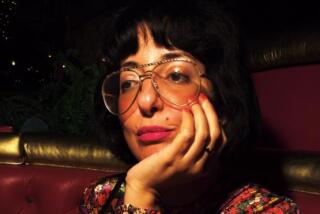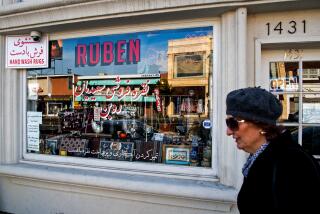POP MUSIC REVIEW : The Sound of Time Present, Time Past : Oshagh Delivers a Program in Irvine of Traditional Iranian Music and New Compositions
IRVINE — Except for lacking a counterpart for Paddy Moloney’s Irish humor, Oshagh could well be considered the Iranian version of the Chieftains. Just as Moloney’s outfit does for Irish traditional music, Oshagh, an Irvine-based group of eight Iranian-Americans, brings the folk music of their homeland to the concert stage with all the majesty and sweep of a classical performance and the spirit and immediacy of a neighborhood gathering.
In performance Sunday at the Irvine Barclay Theatre, Oshagh and singer Zoya Sabet delivered a program of both traditional music and new compositions written in traditional style by the group’s kamancheh player, Mojtaba Khoshzamir.
Some aspects of the music are of recent origin, such as the group’s ensemble arrangements. For much of Iran’s history, music was frowned on by the governing sects and therefore generally performed only before small gatherings by one or two musicians.
On most other counts, including the band’s exotic instrumentation, the music reaches back to antiquity. Those instruments included Khoshzamir’s kamancheh , a remarkably expressive violin-family instrument with a banjo-like animal-skin head; the santur, a 72-stringed hammered dulcimer played by band director Esmail Tehrani; the tar, a peanut-shaped cross between a sitar and a banjo played by Rahmani Pour; the ney , a wood flute played by Hassan Bashiri; the lute-like oud played by Farzaneh Tehrani, one of two women in the band (another improvement on tradition, which had excluded women from performing music); and the goblet-shaped tombak and daf hoop-drum (similar to the Irish bodhran ) played by Reza Torchizy and Pejman Hadadi. The lineup was completed by Pourafar Partow on ghaychak , another violin-like instrument that band spokesman Torchizy said had never been featured on an American stage.
Like the Indian system of ragas, Iranian music is formed in 12 modes, each with its own rhythmic and melodic structures. While these modes can be so formulated as to even dictate minute changes in intonating their semi-tone scales, they also allow considerable room for improvisation and personality to come through. Sunday’s program was divided into performances in two modes, with each featuring seamless segues between various songs and movements.
The most immediately captivating element to ears not overly familiar with the music is the beguiling rhythm. Unlike the simple rhythms of Occidental music, Iranian measures are more often based on five or seven beats, and it’s not unusual to find uneven rhythms combined to come up with even more complex subdivisions of the beat. It doubtlessly helps to grow up with such music, as Oshagh played the complex and shifting beats with a fluidity never approached by the late Don Ellis or other American polyrhythmic pioneers.
Some of the pieces performed in each mode had a stately, reserved quality that suggested court music. Far more, though, seemed to speak of vast spaces and man’s relative place in it, like a solitary, purifying night under desert stars.
Of course, such impressions can be misleading. In the song “Ghasedek,” the highlight of the evening’s performance, Sabet’s voice--a wonder of emotion and control, with an incredible command of the music’s semitone quavers--and Khoshzamir’s almost human-sounding kamancheh wound in a call-and-answer of such heavy lamentation that to English-only ears the song seemed a tragedy of deep and sundered love.
Close, but no cigar: Afterward, Torchizy explained that actually it was a lament on the 1953 military coup that deposed a popular prime minister who had sought to nationalize the nation’s petroleum industry, then controlled by the British Petroleum Co. The song, by Khoshzamir, was based on work by the late Iranian poet Akhvan Sales.
Like the “little orchestra” that the Chieftains are, Oshagh worked with a full palette, playing, as needed, with an orchestral sweep or a hushed intimacy. Some passages featuring the ney and santur seemed almost like Japanese koto music in their spareness and delicate dissonances. One mournful kamancheh solo in the shur mode recalled some of Khachaturian’s violin works based on Armenian folk themes.
While Oshagh’s performance doubtless served an important, unifying function for the transplanted Iranians who filled the hall, it’s a shame more non-Iranians weren’t in attendance. One of the group’s aims is to share its culture with other Americans and thereby foster a greater understanding between the cultures. As Torchizy stated during an introductory speech, “loving is knowing,” and there are few better ways to truly know a people than through their music.
To accomplish that aim, however, the group could make its performances more Occidental-friendly by adding some brief explanations in English about the instrumentation and, more important, about the lyrics. While the mood of the songs usually was implicit, a bit of story line wouldn’t have hurt.
(A further intro to similar music will be David Lindley’s acoustic shows at the Coach House in San Juan Capistrano June 14 and 15. Accompanied only by a tombak player this time out, the worldly string master should be drawing pretty heavily on his Middle Eastern instruments and influences.)
More to Read
The biggest entertainment stories
Get our big stories about Hollywood, film, television, music, arts, culture and more right in your inbox as soon as they publish.
You may occasionally receive promotional content from the Los Angeles Times.
![LOS ANGELES, CA - JUNE 17: [Cody Ma and Misha Sesar share a few dishes from their Persian Restaurant Azizam] on Monday, June 17, 2024 in Los Angeles, CA. (Ethan Benavidez / For The Times)](https://ca-times.brightspotcdn.com/dims4/default/7ffc7f6/2147483647/strip/true/crop/5110x3417+306+0/resize/320x214!/quality/75/?url=https%3A%2F%2Fcalifornia-times-brightspot.s3.amazonaws.com%2F79%2Fdc%2F4d29255545f5b9813315901692bc%2F1459972-fo-azizam-review20-eba.JPG)









